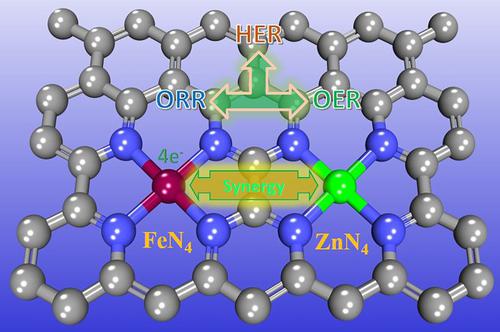Nano Research ( IF 9.5 ) Pub Date : 2020-11-06 , DOI: 10.1007/s12274-020-3072-6 Yongcheng Li , Riming Hu , Zhibin Chen , Xin Wan , Jia-Xiang Shang , Fu-He Wang , Jianglan Shui

|
Due to the high specific surface area, abundant nitrogen and micropores, ZIF-8 is a commonly used precursor for preparing high performance Fe-N-C catalysts. However, the Zn element is inevitably remained in the prepared Fe-N-C catalyst. Whether the residual Zn element affects the catalytic activity and active site center of the Fe-N-C catalyst caused widespread curiosity, but has not been studied yet. Herein, we built several Fe, Zn, and N co-doped graphene models to investigate the effect of Zn atoms on the electrocatalytic performance of Fe-N-C catalysts by using density functional theory method. The calculation results show that all the calculated Fe-Zn-Nx structures are thermodynamically stable due to the negative formation energies and relative stabilities. The active sites around Fe and Zn atoms in the structure of Fe-Zn-N6(III) show the lowest oxygen reduction reaction (ORR) and oxygen evolution reaction (OER) overpotentials of 0.38 and 0.43 V, respectively. The bridge site of Fe-Zn in Fe-Zn-N5 shows the lowest ηHER of −0.26 V. A few structures with a better activity than that of FeN4 or ZnN4 are attributed to the synergistic effects between Fe and Zn atoms. The calculated ORR reaction pathways on Fe-Zn-N6(III) show that H2O is the final product and the ORR mechanism on the catalyst would be a four-electron process, and the existence of Zn element in the Fe-N-C catalysts plays a key role in reducing the ORR activation energy barrier. The results are helpful for the deep understand of high-performance Fe-N-C catalysts.
中文翻译:

Fe-NC催化剂中锌原子对电催化反应的影响:理论考虑
由于高的比表面积,丰富的氮和微孔,ZIF-8是制备高性能Fe-NC催化剂的常用前体。但是,Zn元素不可避免地残留在制备的Fe-NC催化剂中。残留的锌元素是否影响Fe-NC催化剂的催化活性和活性位点中心引起广泛的好奇心,但尚未进行研究。在这里,我们建立了几个Fe,Zn和N共掺杂的石墨烯模型,以利用密度泛函理论方法研究Zn原子对Fe-NC催化剂电催化性能的影响。计算结果表明,所有计算出的Fe-Zn-N x由于负的形成能和相对的稳定性,结构是热力学稳定的。Fe-Zn-N 6(III)结构中的Fe和Zn原子周围的活性位点分别显示出最低的氧还原反应(ORR)和氧释放反应(OER)过电势,分别为0.38和0.43V。的Fe-Zn的Fe基ZNN桥位5示出了最低η HER -0.26具有比芬的更好的活性V.几个结构的4或ZNN 4归因于铁和锌原子之间的协同效应。在Fe-Zn-N 6(III)上计算的ORR反应路径表明,H 2O是最终产物,催化剂上的ORR机理是四电子过程,Fe-NC催化剂中Zn元素的存在对降低ORR活化能垒起关键作用。结果有助于深入了解高性能Fe-NC催化剂。









































 京公网安备 11010802027423号
京公网安备 11010802027423号